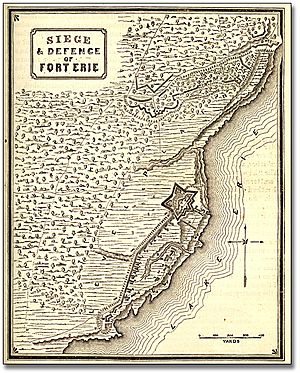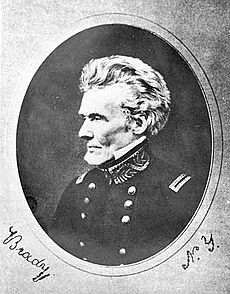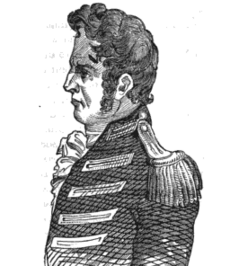Siege of Fort Erie facts for kids
Quick facts for kids Siege of Fort Erie |
|||||||
|---|---|---|---|---|---|---|---|
| Part of the War of 1812 | |||||||
|
|||||||
| Belligerents | |||||||
| Commanders and leaders | |||||||
| Gordon Drummond | Edmund P. Gaines Eleazer Wheelock Ripley Jacob Brown |
||||||
| Strength | |||||||
| 4,800 | 2,800 | ||||||
| Casualties and losses | |||||||
| At least 285 killed 508 wounded 748 captured 12 missing Total: 1,551 |
213 killed 565 wounded 240 captured 57 missing Total: 1,075 |
||||||
The Siege of Fort Erie was a major battle during the War of 1812. It happened from August 4 to September 21, 1814. In this battle, American forces successfully defended Fort Erie against a British army. The British tried to capture the fort but failed, suffering many losses.
During the siege, the British tried to storm the fort but were pushed back. Many British soldiers also got sick because of the bad weather and poor living conditions. The Americans then launched a surprise attack, called a sortie, to destroy British cannons. Both sides had many casualties in this fight.
After the British left, the American army moved forward carefully. They forced the British to retreat again at Cook's Mills. But as winter came and supplies ran low, the Americans decided to leave the area. They destroyed Fort Erie before they left. This siege was one of the last big British attacks on the northern border.
Contents
Why the Siege Happened
American Advance and Retreat
In July 1814, American Major General Jacob Brown led his troops across the Niagara River. They quickly captured Fort Erie. After winning a battle at Chippawa, they moved north. However, the British brought in more soldiers to the Niagara area.
On July 25, a very bloody battle happened at Lundy's Lane. It was a tough fight for both sides, and neither truly won. General Brown was badly hurt during this battle.
After Lundy's Lane, the American troops were outnumbered. They were led by Brigadier General Eleazer Wheelock Ripley and went back to Fort Erie. Ripley thought they should leave the fort and cross the Niagara River. But General Brown disagreed. He called Brigadier General Edmund P. Gaines to take command instead.
British Plans to Attack
The British, led by Lieutenant General Gordon Drummond, also lost many soldiers at Lundy's Lane. Drummond still believed the Americans had been forced to retreat. He wanted to drive them completely out of Canada. His troops followed the Americans slowly, reaching Fort Erie on August 4.
Drummond's army had about 3,000 soldiers. But he was worried about how well-trained they were. This slow advance gave the Americans important time to get ready and make their defenses stronger.
Fort Erie's Defenses
The original Fort Erie had two main buildings and strong cannon areas. These were connected by a thick stone wall. The back of the fort, facing away from Lake Erie, had an open area with two small forts, called redoubts. These redoubts were not fully built and offered little protection.
The front of the fort had a large earth wall with cannons. A deep, dry ditch surrounded the fort. Inside this ditch was a tall wooden wall with sharp points. This wall was angled outwards to stop enemies from jumping in. The ditch also had sharp sticks to hurt attacking soldiers. The defenders used the ditch for garbage, making it slippery and smelly. This would slow down attackers and spread disease.
Since taking the fort, the Americans had greatly improved its defenses. They extended the earth wall south for about 800 meters. This wall went to a sandy hill called Snake Hill, where they built a cannon battery. To protect the north side, they built another earth wall connecting the fort to the lake. On the shore, they built another strong cannon spot called the Douglass Battery. They also placed Abatis (obstacles made of fallen trees) in front of the earth walls.
By the end of the siege, the Americans had also built three wooden blockhouses behind the fort. They made all the defenses and redoubts much stronger.
Before the Main Attack
British Raid on Buffalo
On August 3, General Drummond sent British soldiers across the Niagara River in small boats. Their goal was to attack Buffalo and Black Rock. They hoped to capture or destroy American supplies. The force had about 600 men.
The raid failed. When they landed, the British found that a bridge over Conjocta Creek was destroyed. They could not cross the creek. American soldiers were defending the creek, stopping the British from fixing the bridge. The British lost 10 killed, 17 wounded, and 6 captured. The Americans lost 2 killed and 8 wounded.
While the British built their siege lines, three American schooners (small sailing ships) in the Niagara River kept firing at them. On August 12, British sailors and Royal Marines dragged a small boat and five other boats overland. They launched a surprise attack on the American schooners near Fort Erie that night.
The American crews saw them coming but were tricked into thinking they were friendly supply boats. The British got close enough to board the ships. They captured the USS Ohio and USS Somers. The crew of the USS Porcupine escaped by cutting their anchor ropes. This British victory boosted their spirits.
The British Attack
On August 13, Drummond started firing cannons at the fort. But his cannons were too far away to do much damage. On the night of August 15-16, Drummond launched a big attack. He planned a three-part assault, with each part aiming at a different American cannon area.
The largest group, with 1,300 soldiers, would try to go around the south side at Snake Hill. Another group of 700 soldiers would attack the Douglass Battery and the north side. A third group of 360 soldiers, sailors, and marines would attack the fort itself.
The British soldiers moved out after dark. But the Americans in the fort had seen their preparations. It would be hard to surprise them. The British cannons stopped firing an hour before the attack began.
American Defenders Ready
Inside the fort, General Gaines ordered his men to be ready. This was a good decision because it meant they were prepared when the attack came. He also made sure all the cannons were loaded correctly so they wouldn't misfire in the rain.
Brigadier General Ripley defended Snake Hill with two U.S. Infantry regiments. Snake Hill had six cannons. The fort itself was defended by two companies of infantry and three cannons. The wall between the fort and the Douglass Battery was guarded by other infantry units and one cannon.
Another long wall was defended by Brigadier General Peter Buell Porter and his troops, along with five cannons. Two companies of infantry and some dragoons (soldiers on horseback) were kept in reserve.
Fischer's Attack on Snake Hill
Lieutenant Colonel Victor Fischer's column attacked Snake Hill. Many of his soldiers were from different parts of Europe, and some were former prisoners. They were ordered to remove their gun flints and use only bayonets.
They met an American guard post about 300 meters from the defenses. The British almost surprised them, but the sound of their movement through tall, wet grass gave them away. The American guards fired, alerting the fort, and then quickly retreated.
As the British reached the obstacles, the American cannons on Snake Hill opened fire. The cannons fired so fast they were called "Towson's Lighthouse." After several tries, many British attackers ran away in a panic. Some ladders they brought were too short to get over the walls. Some soldiers tried to swim around the defenses in the Niagara River, but the current was too strong, and many drowned or were captured.
Some British units charged the battery five times before giving up. Ripley, who was in charge of this area, reported taking 147 prisoners. His men had only a dozen casualties. Fischer's attack failed completely.
Scott's Attack on Douglass Battery
Colonel Hercules Scott's column attacked the Douglass Battery. As soon as firing started at Snake Hill, Scott's men moved forward. American guards quickly spotted them and fired their muskets to warn the defenders.
When the British got close, the fort's cannons and the Douglass Battery fired canister shot, which is like a giant shotgun blast. This caused terrible losses for the British, who were squeezed into a narrow space between a hill and the lake. Colonel Scott was badly wounded early on. His second-in-command was also seriously hurt. Scott's regiment was shattered, with 360 casualties. The Americans facing them had no casualties from this attack.
William Drummond's Attack on the Fort
Lieutenant Colonel William Drummond's column attacked the fort itself. They used the darkness and smoke to move through the ditch and attack the northeast part of the fort. They surprised the American artillerymen there, who quickly ran away.
Some American soldiers fought back bravely but were killed. A group of American infantry reorganized and fired into the fort's bastion. It is believed that Drummond was killed during this intense firing.
The attackers tried twice to get into the fort's main area but couldn't break into the buildings. The defenders tried to take back the northeast part of the fort but were pushed back. General Drummond sent only a few more soldiers to help, but most of them were lost.
After fighting for almost an hour, some Americans turned an 18-pounder cannon around. They fired it into the bastion from less than 50 yards away. The British tried to fire back with a captured cannon.
Then, a huge powder magazine (storage for gunpowder) in the bastion exploded. The explosion destroyed the entire bastion and much of the nearby building. A two-ton cannon was thrown 100 yards out of the fort. Between 150 and 250 men, mostly British and Canadians, were killed in the explosion. Many attackers were blown into the ditch below. The explosion caused chaos for both sides. The remaining attackers thought the whole fort was mined and ran away in a panic. Drummond's column was almost completely wiped out.
After the Attack
In total, the British lost 57 killed, 309 wounded, and 537 missing. Many of the missing were killed in the explosion. An American report said they captured 360 prisoners, with 174 of them wounded. General Gaines reported that 222 dead British soldiers were found in and around the fort.
The American defenders lost 17 killed, 56 wounded, and 11 missing.
American Counterattacks
Even after the heavy losses from the attack, Lieutenant General Drummond's army suffered greatly from sickness and bad weather. The British soldiers had no tents, and their simple shelters offered little protection. When the autumn rains started, the ground became very muddy. Drummond did get more soldiers, but he continued the siege.
On August 29, a British cannon shot badly wounded General Gaines. Brigadier General Ripley took command again. Ripley was not very hopeful about the situation. Major General Jacob Brown, who was still recovering from his wounds, returned to Fort Erie to take command. Brown decided to attack the British.
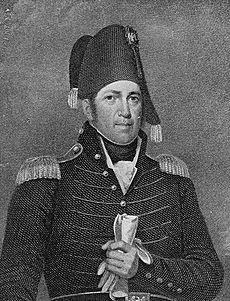
Attack on September 4
On September 4, a group of American volunteers attacked British Battery No. 2. The fight lasted for almost six hours. It stopped because of a "tremendous rain and thunder storm." During this fight, Colonel Joseph Willcocks, a Canadian fighting for the Americans, was killed.
Attack on September 17
On September 15, the British finally finished Battery No. 3. This battery could fire along most of the American defenses. Brown planned to go around the British lines, capture the batteries, and make their cannons useless. Brigadier General Porter led the main attack. His men cleared a path through the woods to get behind British Battery No. 3. The British soldiers, who were tired and sick, did not notice this activity.
At noon on September 17, Porter's force of 1,600 men moved along the path in heavy rain. They completely surprised the British soldiers guarding the end of the siege works and captured Battery No. 3. At the same time, Brigadier General James Miller led other American soldiers and attacked the British center. Attacked from two sides, Battery No. 2 was also captured.
British reserves quickly rushed forward. There was fierce fighting in the British trenches. The Americans could not capture Battery No. 1 and were pushed out of Batteries No. 2 and No. 3. Brown ordered his men back to the fort.
Three of the six British siege cannons in Battery No. 3 were destroyed. In this two-hour battle, the Americans lost 79 killed, 216 wounded, and 216 missing. Porter, Miller, and Ripley were all wounded.
The British reported 115 killed, 178 wounded, and 316 missing. The Americans took 382 prisoners.
End of the Siege
The Americans did not know that Drummond had already decided on September 16 to end the siege. He had ordered his cannons to be moved. It was not until the night of September 21 that the British army finally pulled back. Drummond wrote that constant heavy rain, sick soldiers, and lack of camp equipment were his reasons for leaving. His army was down to 2,000 healthy soldiers, and his camp looked like "a lake in the midst of a thick wood."
From August 1 to September 21, the American defenders lost 104 killed and 250 wounded. Most of these were regular U.S. Army soldiers.
Leaving the Fort
In early September, Major General George Izard's army was ordered to march to Sackett's Harbor. They arrived on September 17. On September 21, American ships moved most of Izard's army to reinforce Brown. Since Izard was the higher-ranking officer, he took command of the combined American force. The Americans now had 6,300 soldiers, much more than Drummond's 2,500.
Brown wanted to attack right away. But Izard waited until October 13 before moving forward carefully. By then, the British had recovered and made their defenses stronger. After some small fights, Izard pulled back.
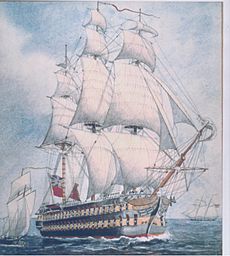
On October 15, the British launched a very large warship, the HMS St Lawrence, on Lake Ontario. This meant the Americans could no longer easily move supplies to the Niagara area by water. At the same time, the British could now easily resupply their troops.
Izard, who was short on supplies, decided to abandon Fort Erie. On November 5, the Americans set off mines and destroyed the fort before crossing the river. This allowed the British to also go into winter camps. Many officers, including Brown, thought Izard was too cautious.
When the British returned to Fort Erie, they chose not to rebuild it because they didn't have enough money. They completely abandoned the fort in 1821 and tore it down from 1823 onwards.
Legacy
Today, nine active U.S. Army infantry battalions carry on the history of the American units that fought at Fort Erie.
Eight British Army regiments were given the "Niagara" Battle Honour for their service in the Niagara area in 1814. Modern units like The Royal Regiment of Fusiliers and the Royal Irish Regiment are their descendants. In Canada, the Royal New Brunswick Regiment remembers the 104th Regiment and also has the "Niagara" Battle Honour.
The "Niagara" Battle Honour was also given to the Glengarry Light Infantry Fencibles and the Battalion of Incorporated Militia of Upper Canada. In the modern Canadian army, units like the Stormont, Dundas and Glengarry Highlanders and the Lincoln and Welland Regiment remember these units.



